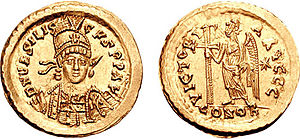Basiliscus

Basiliskos ( ancient Greek Βασιλίσκος , Latin Flavius Basiliscus ; † 476) was the usurper of Eastern Roman emperors in the years 475 and 476.
Basiliscus was the brother of Empress Verina and thus the brother-in-law of the Eastern Roman Emperor Leo I , who ruled from 457 to 474. He was consul of the year 465 and commander in the failed campaign against the vandal king Geiseric in the year 468. In later sources Basiliscus is accused either of treason or failure in this context.
The antipathy against the new emperor Zenon , whose legitimacy was controversial, led to a conspiracy in the palace at the end of 475, but Zenon learned of it, so that he managed to flee the city on January 9, 475. A day later, Basiliscus was made emperor, who ascended the throne with the approval of the Senate. In the background his sister Verina is said to have pulled the strings; in any case, she was the one to crown him.
Basiliscus was officially recognized as a colleague by the western emperor Romulus Augustulus , who was himself a usurper, according to some inscriptions. In any case, he crowned his wife Zenonis as empress, he raised his son Marcus to Caesar and a little later to Augustus (co-emperor).
However, when Zenon returned from Isauria with a strong army in the following year and appeared in front of Constantinople , the mismanagement of Basilicos and the dissatisfaction with him resulting from his religious policy, among other things, led to his troops abandoning him. Basiliscus was overthrown with the significant participation of the generals Illus and Armatus : the gates were opened to Zenon, and he ascended the throne again in July or early August 476.
Some late ancient sources such as Malalas report that Basiliscus fled to the protection of a church , but then surrendered himself and his family to Zeno under the solemn promise that no blood would be shed. Zeno, it is said, kept his promise in his own way: he sent his prisoners to Limna in Cappadocia and had them walled up in a dry cistern where they starved to death. Whether this story is true is uncertain; The only thing that is certain is that Basiliscus found death.
In Wachtendonk the Lower Rhine in 2019 a fresh embossed gold coin was discovered that emerged also under Basiliskos. It has the same structure as the coin described above, but bears the inscription "D (ominus) N (oster) bASILISCI ET MARC P AVG" ('Our Lords Basiliscus and Marcus the happy exalted ones'). Here the winged goddess of victory also wears a gemed cross, to the right of her is a star. The inscription reads "VICTORIA AVG GG", below CONOB can be read, which is a quality label. According to the standard at the time, the coin weighs 4.47 g and has a diameter of 20 mm.
literature
- Wolfram Brandes : Family ties? Odoacer, Basiliscus and Harmatios . In: Klio 75 (1993), pp. 407-437.
- Peter Crawford: The Roman Emperor Zeno. The Perils of Power Politics in Fifth-Century Constantinople . Pen & Sword, Barnsley 2019.
- Ludo Moritz Hartmann : Basiliscus 2) . In: Paulys Realencyclopadie der classischen Antiquity Science (RE). Volume III, 1, Stuttgart 1897, Col. 101 f.
- John Robert Martindale: Basiliscus 2. In: The Prosopography of the Later Roman Empire (PLRE). Volume 2, Cambridge University Press, Cambridge 1980, ISBN 0-521-20159-4 , pp. 212-214.
- Jan Prostko-Prostynski: Basiliscus . A usurper recognized in Rome . In: Zeitschrift für Papyrologie und Epigraphik 133 (2000), pp. 259–265; here online (PDF; 69 kB).
- Michael Redies: The Usurpation of the Basiliscus (475–476) in the context of the rising Monophysite Church , in: Antiquité Tardive 5 (1997), 211–221.
- Alexios G. Savvides, Benjamin Hendrickx (Eds.): Encyclopaedic Prosopographical Lexicon of Byzantine History and Civilization . Vol. 2: Baanes-Eznik of Kolb . Brepols Publishers, Turnhout 2008, ISBN 978-2-503-52377-4 , pp. 79-80.
Web links
- Hugh Elton: Short biography (English) at De Imperatoribus Romanis (with references).
Remarks
- ↑ K. Kraus: Of particular value , in: Archeology in Germany 01 | 2020, p. 58 f.
| personal data | |
|---|---|
| SURNAME | Basiliscus |
| ALTERNATIVE NAMES | Flavius Basiliscus |
| BRIEF DESCRIPTION | Eastern Roman counter-emperor in the years 475 and 476 |
| DATE OF BIRTH | 5th century |
| DATE OF DEATH | 476 |